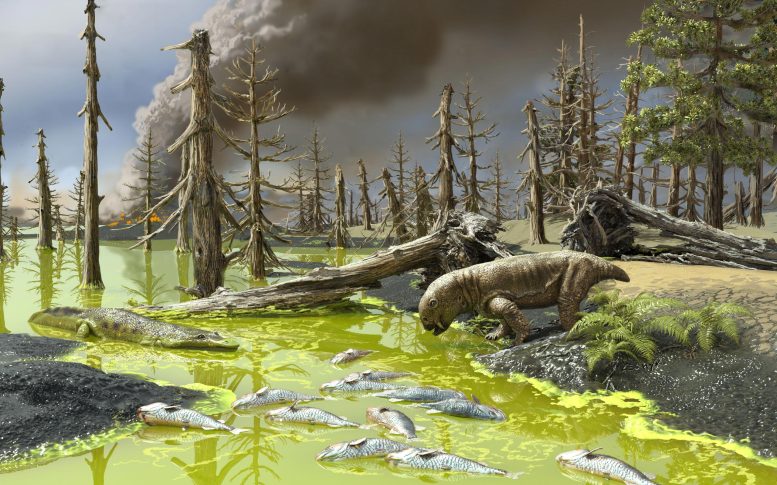Animals Died in “Toxic Soup” During Earth’s Worst Mass Extinction – A Warning for Today

An artist’s rendering of the conditions during the End-Permian Mass Extinction, which wiped out nearly all life on earth. (Illustration by Victor Leshyk
‘The end-Permian is one of the best places to look for parallels with what’s happening now.’
The end-Permian mass extinction event of roughly 252 million years ago – the worst such event in earth’s history – has been linked to vast volcanic emissions of greenhouse gases, a major temperature increase, and the loss of almost every species in the oceans and on land.
Now, it seems that even the lakes and rivers were no safe havens. A recent study published by an international team of researchers including Professor and Head of the Department of Geosciences Tracy Frank and Professor Chris Fielding, both newly arrived at UConn, has identified a new cause of extinction during extreme warming events: toxic microbial blooms.
In a healthy ecosystem, microscopic algae and cyanobacteria provide oxygen to aquatic animals as a waste product of their photosynthesis. But when their numbers get out of control, these microbes deplete free oxygen, and even release toxins into the water. By studying the fossil, sediment, and chemical records of rocks near Sydney, Australia, the researchers discovered that several pulses of bloom events had occurred soon after the first volcanic rumblings of the end-Permian mass extinction. Once the bottom-feeder animals, or “detritivores,” were killed off, there was no one left to keep the microbes in check. The freshwater systems then seethed with algae and bacteria, delaying the recovery of animals for perhaps millions of years.
Frank and Fielding study sediment, and Frank explains their contribution to the work, which was performed while both were at the University of Nebraska–Lincoln, was in gleaning details about the conditions of the environment, and the resulting toxic soup, from the layers of sediment.
“We are trying to understand what conditions these plants were living in, for instance were they lake deposits versus river deposits?” Frank says. “Then what can we determine details about the salinity and temperatures of the waters, those details come from the geochemistry.”
The three main ingredients for the toxic soup are accelerated greenhouse gas emissions, high temperatures, and abundant nutrients. The volcanic eruptions provided the first two, while sudden deforestation caused the third. When the trees were wiped out, the soils bled into the rivers and lakes, providing all the nutrients that the microbes would need. When the researchers compared the fossil records of different warming-related mass extinctions, the team found extremely similar fossil records. This implicates deadly microbial blooms as repeat offenders of freshwater extinctions during extreme warming events.
Today, humans have been following this recipe, and freshwater microbial blooms have been on the rise, illustrating how important the geosciences are in understanding the past in ways that offer crucial context for understanding contemporary changes in climate.
“We’re seeing more and more toxic algae blooms in lakes and in shallow marine environments that’s related to increases in temperature and changes in plant communities which are leading to increases in nutrient contributions to freshwater environments,” Frank says. “So, a lot of parallels to today. The volcanism was a source of CO2 in the past but we know that the rate of CO2 input that was seen back then was similar to the rate of CO2 increases we’re seeing today because of anthropogenic effects.
“We can get a sense of how much climate has changed in the past, what the extremes are, how fast it can change, what the causes of climate change are and that gives us a nice backdrop for understanding what’s happening today.”
According to this year’s report by the Intergovernmental Panel on Climate Change (IPCC), the influence of humans on the changing climate is “unequivocal,” creating conditions that favor the spread of these warmth-loving microbes. In combination with an influx of nutrients from water pollution, mostly from agriculture and deforestation, this has led to a sharp increase in toxic blooms. The results: mass fish die-offs, severe human and livestock health effects, and an annual cost measurable in billions of dollars.
“The end-Permian is one of the best places to look for parallels with what’s happening now,” says Fielding.
“The other big parallel is that the increase in temperature at the end of the Permian coincided with massive increases in forest fires. One of the things that that destroyed whole ecosystems was fire, and we’re seeing that right now in places like California. One wonders what the longer-term consequences of events like that as they are becoming more and more widespread.”
These are clear symptoms of an unbalanced ecosystem, and the present study indicates that the impacts of bloom events can echo for an extremely long time. However, unlike the species that suffered the mass extinctions of the past, we have the opportunity to prevent these toxic blooms by keeping our waterways clean and curbing our greenhouse gas emissions.
“The scary thing is we are used to thinking in terms of timescales of years, maybe tens of years, if we get really adventurous. The end-Permian mass extinction event took four million years to recover from. That’s sobering,” says Fielding.
No comments:
Post a Comment